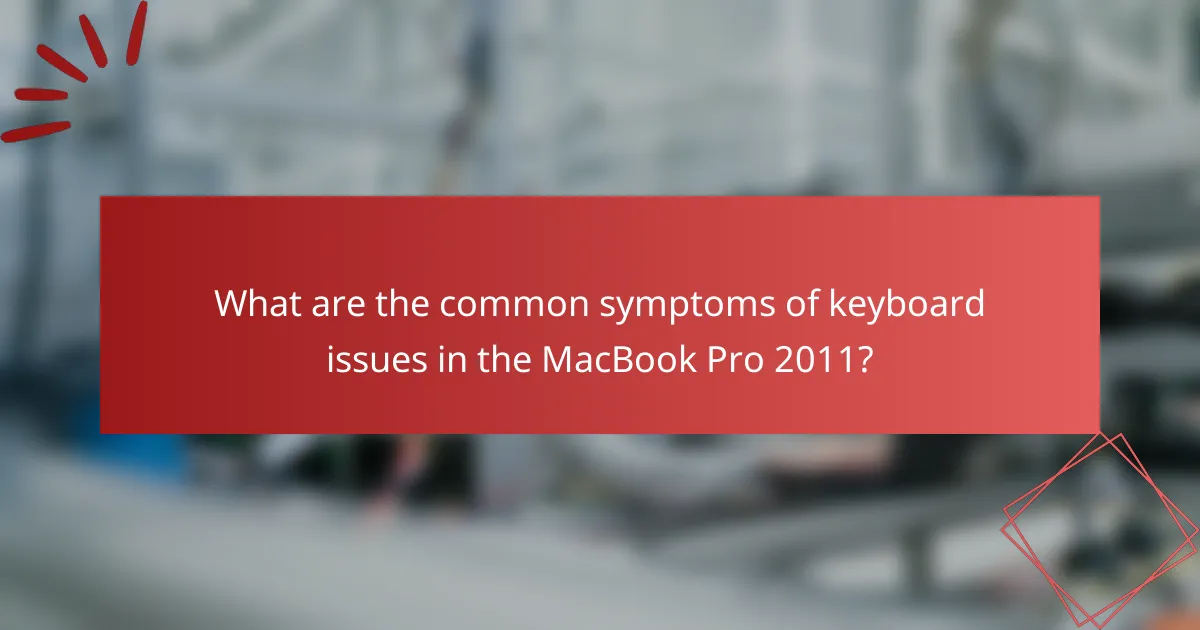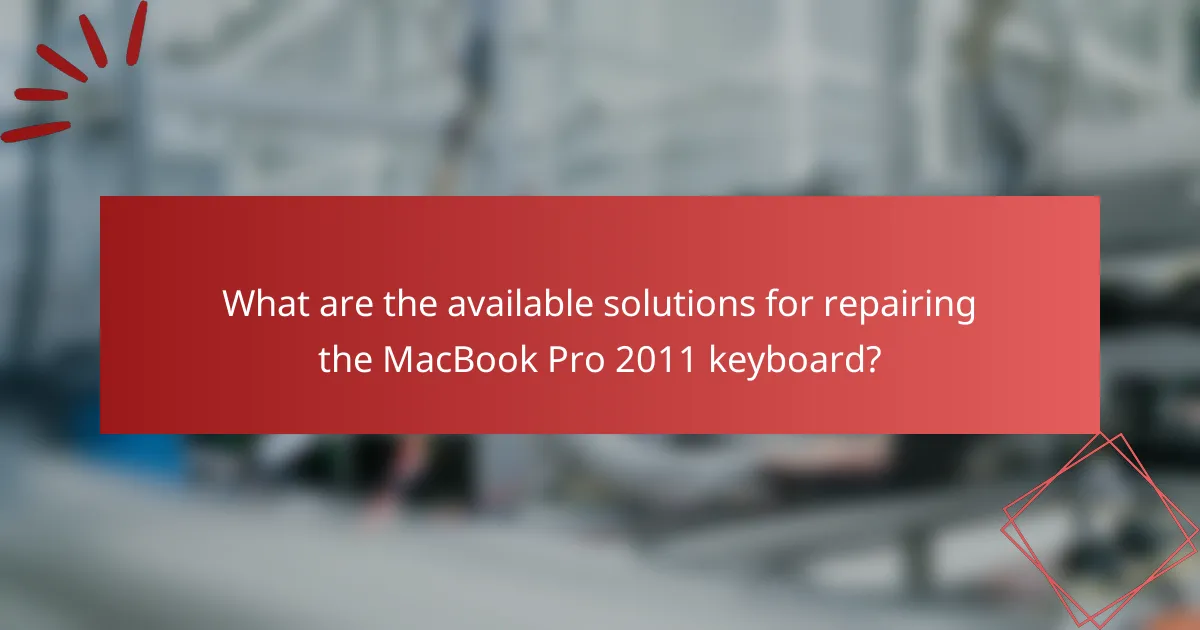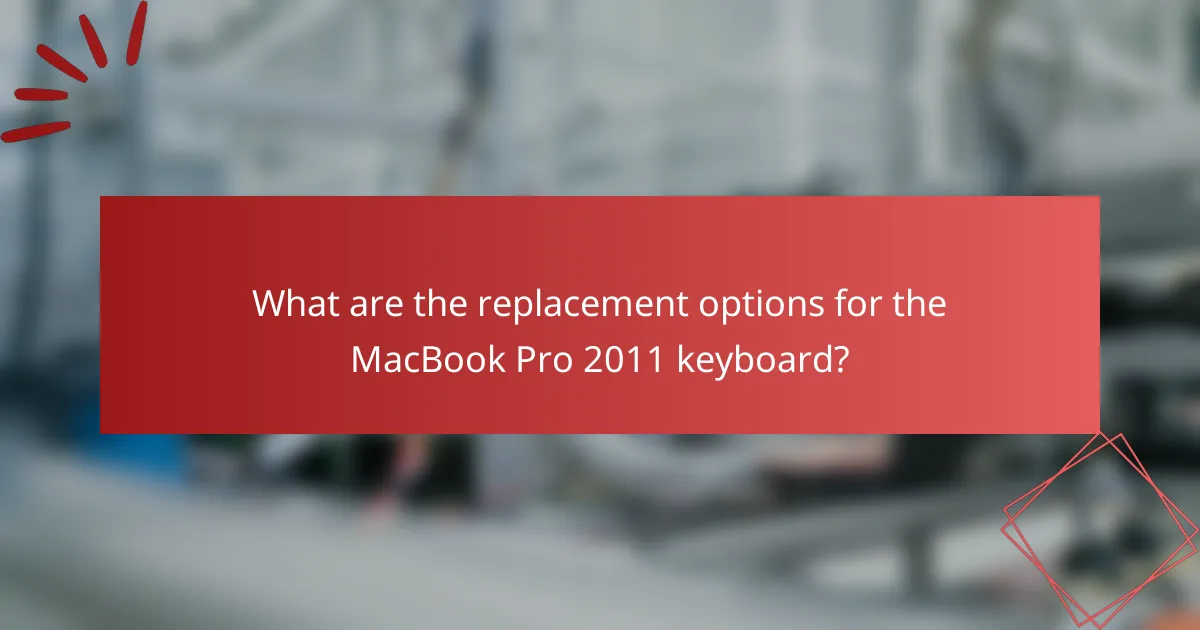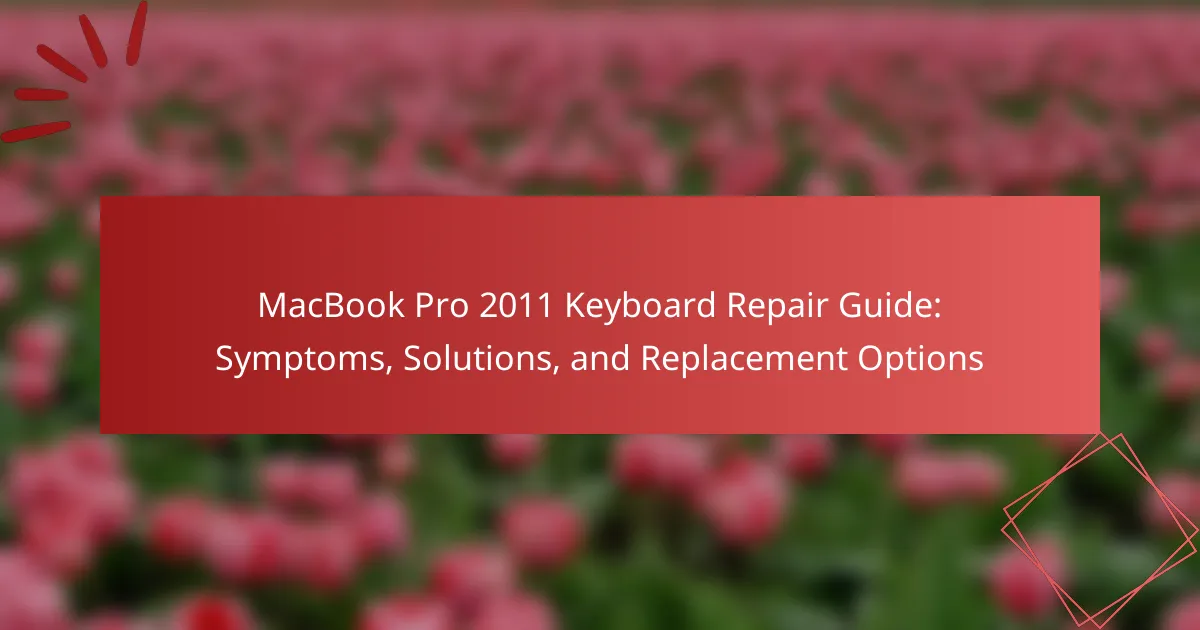The MacBook Pro 2011 keyboard is prone to various issues, including unresponsive keys, sticky keys, and incorrect character output. Users may experience intermittent key failures, requiring excessive force to activate certain keys or encountering unexpected key behavior, such as repeated inputs. Solutions for these keyboard problems range from cleaning and replacing individual key switches to complete keyboard replacement. Replacement options include OEM keyboards that match original specifications and third-party alternatives that may offer cost savings and additional features. Ensuring compatibility with the MacBook Pro 2011 model is crucial when selecting a replacement.

What are the common symptoms of keyboard issues in the MacBook Pro 2011?
Common symptoms of keyboard issues in the MacBook Pro 2011 include unresponsive keys, sticky keys, and keys that produce incorrect characters. Users may experience intermittent key failures where certain keys do not register when pressed. Additionally, keys may feel stuck or require excessive force to activate. Some users report unexpected behavior, such as keys repeating when pressed once. These symptoms can arise from hardware malfunctions or debris accumulation under the keys. Regular cleaning and maintenance are recommended to mitigate these issues.
How can I identify if my MacBook Pro 2011 keyboard is malfunctioning?
To identify if your MacBook Pro 2011 keyboard is malfunctioning, test each key for responsiveness. A malfunctioning keyboard may show unresponsive keys or keys that repeat characters unexpectedly. Check for physical damage, such as debris or liquid spills. Use the Keyboard Viewer in System Preferences to ensure all keys register correctly when pressed. If the keyboard fails to respond to multiple keys, it may indicate a hardware issue. Running Apple Diagnostics can also help identify keyboard-related problems. If issues persist after these tests, consider professional servicing or replacement.
What specific signs indicate keyboard failure in the MacBook Pro 2011?
Specific signs of keyboard failure in the MacBook Pro 2011 include unresponsive keys, keys that stick or feel different from others, and intermittent key functionality. Additionally, some users may experience repeated characters when a key is pressed once. Another sign is when certain keys do not register at all, leading to typing errors. These issues can often be traced back to hardware malfunctions or liquid damage. The MacBook Pro 2011 is known for keyboard problems, particularly due to wear and tear over time.
How do different symptoms vary in severity and impact?
Different symptoms of keyboard issues in a MacBook Pro 2011 vary in severity and impact. For instance, key sticking may cause minor frustration but does not hinder overall functionality. In contrast, complete keyboard failure renders the device unusable, significantly impacting productivity. Other symptoms, like intermittent key response, can lead to typing errors, affecting user experience. Severity can also depend on the frequency of the symptoms; occasional sticking is less severe than persistent unresponsiveness. Understanding these variations helps in prioritizing repair actions effectively.
What causes keyboard issues in the MacBook Pro 2011?
Keyboard issues in the MacBook Pro 2011 are primarily caused by dust and debris accumulation under the keys. This accumulation can lead to keys sticking or becoming unresponsive. Additionally, liquid spills can damage the keyboard’s circuitry, resulting in malfunction. Wear and tear over time can also cause key failure. In some cases, a faulty keyboard connector can lead to communication issues between the keyboard and the logic board. These factors contribute to the overall reliability problems experienced by users of this model.
How does wear and tear affect keyboard performance?
Wear and tear significantly degrades keyboard performance over time. The physical components of the keyboard, such as keys and switches, can become less responsive. Frequent use leads to keycap wear, which affects tactile feedback. Dirt and debris accumulation can hinder key movement and responsiveness. Additionally, internal components may weaken, causing inconsistent electrical connections. Studies show that keyboards can lose functionality after extensive use, with some keys becoming completely unresponsive. Regular maintenance can mitigate these effects, but prolonged neglect typically results in diminished performance.
What role does environmental exposure play in keyboard problems?
Environmental exposure plays a significant role in keyboard problems. Dust, moisture, and temperature fluctuations can damage keyboard components. Dust accumulation can lead to key sticking or malfunction. Moisture exposure can cause electrical shorts or corrosion. High temperatures may warp or degrade plastic components. A study by the International Journal of Computer Science and Information Security found that environmental factors directly affect electronic device longevity. Proper maintenance and protective measures can mitigate these risks.

What are the available solutions for repairing the MacBook Pro 2011 keyboard?
Available solutions for repairing the MacBook Pro 2011 keyboard include cleaning, replacing key switches, and full keyboard replacement. Cleaning involves removing debris and dust from under the keys. This can often resolve issues with sticky or non-responsive keys. Replacing individual key switches is an option if specific keys are malfunctioning. This requires careful disassembly and soldering skills. Full keyboard replacement is necessary when multiple keys fail or the keyboard is damaged beyond repair. Replacement keyboards are available from authorized Apple service providers and third-party vendors. Each solution addresses different levels of keyboard issues, providing users with options based on their specific problems.
How can I troubleshoot keyboard issues before seeking repairs?
Check the keyboard connections first. Ensure the keyboard cable is securely connected to the logic board. Restart the MacBook Pro to reset any temporary software issues. Test the keyboard in a different user account to identify if the problem is user-specific. Run Apple Diagnostics to check for hardware issues. Inspect for physical damage or debris under the keys. Clean the keyboard with compressed air to remove any obstructions. If the issue persists, consider resetting the System Management Controller (SMC) and the NVRAM. These steps often resolve common keyboard problems before seeking professional repairs.
What basic steps can I take to fix minor keyboard problems?
To fix minor keyboard problems, start by cleaning the keyboard. Use compressed air to remove debris between keys. Check for stuck keys and gently press them to release. Ensure the keyboard is connected properly if it’s detachable. Restart the MacBook Pro to reset any software glitches. Update the operating system to fix potential software issues. Test the keyboard in a different user account to rule out user-specific settings. If problems persist, consider resetting the System Management Controller (SMC). These steps address common minor keyboard issues effectively.
When should I consider professional repair services?
You should consider professional repair services when your MacBook Pro 2011 keyboard exhibits persistent issues. Signs include unresponsive keys, repeated characters, or keys sticking. If troubleshooting steps do not resolve these problems, professional help is advisable. Additionally, if you notice liquid damage or physical wear, experts should assess the damage. Repairing complex components requires specialized tools and knowledge. Attempting DIY repairs can lead to further issues or void warranties. Professional services ensure that repairs are performed correctly and safely. They also provide warranties for their work, offering peace of mind.
What DIY repair options are available for the MacBook Pro 2011 keyboard?
DIY repair options for the MacBook Pro 2011 keyboard include cleaning, keycap replacement, and keyboard replacement. Cleaning involves using compressed air to remove debris and dust from beneath the keys. Keycap replacement can be done by gently prying off individual keys and replacing them with new ones. If the keyboard is malfunctioning, a full keyboard replacement may be necessary. This requires disassembling the MacBook and installing a new keyboard unit. These repairs can improve functionality and extend the life of the device.
How can I replace individual keys or the entire keyboard?
To replace individual keys on a MacBook Pro 2011, carefully pry off the damaged key using a plastic tool. Align the new keycap with the scissor mechanism and press down until it clicks into place. For replacing the entire keyboard, first power off the MacBook and remove the bottom case. Disconnect the keyboard cable from the logic board. Remove the screws securing the keyboard and lift it out. Place the new keyboard in position, reconnect the cable, and reassemble the bottom case. This process is supported by repair guides and videos available on platforms like iFixit, demonstrating step-by-step instructions for both key and keyboard replacement.
What tools and materials do I need for a DIY keyboard repair?
For a DIY keyboard repair, you need a set of specific tools and materials. Essential tools include a screwdriver set, particularly a P5 Pentalobe screwdriver for MacBook Pro models. You will also need a plastic spudger for prying open the keyboard without damage. Tweezers can assist in handling small components. Additionally, a cleaning brush is useful for removing debris from under keys.
Materials required include replacement keycaps or a full keyboard if necessary. You may also need adhesive or double-sided tape for reattaching components. Anti-static wrist straps can prevent damage from static electricity. Finally, having a workspace with good lighting is beneficial for visibility during the repair process.

What are the replacement options for the MacBook Pro 2011 keyboard?
Replacement options for the MacBook Pro 2011 keyboard include OEM (Original Equipment Manufacturer) keyboards and third-party keyboards. OEM keyboards are designed to match the original specifications and quality. They can be purchased from Apple or authorized retailers. Third-party keyboards often come at a lower cost and may offer different features. Brands like iFixit and OWC provide compatible replacement keyboards. Installation can be done by professionals or DIY enthusiasts with the right tools. It is essential to ensure compatibility with the MacBook Pro 2011 model before purchasing.
What types of keyboard replacements are compatible with the MacBook Pro 2011?
The compatible keyboard replacements for the MacBook Pro 2011 include both OEM (original equipment manufacturer) and third-party keyboards. OEM keyboards are designed specifically for the MacBook Pro 2011 model, ensuring a perfect fit and functionality. Third-party keyboards may vary in quality and compatibility, so it is essential to choose reputable brands. Key specifications to consider are the layout, connector type, and compatibility with the MacBook’s hardware. The MacBook Pro 2011 typically uses a scissor-switch mechanism, which should be matched in replacements.
How do OEM parts compare to third-party replacements?
OEM parts are original equipment manufacturer components, while third-party replacements are produced by other manufacturers. OEM parts typically offer higher quality and compatibility with the device. They are designed to meet the specific standards set by the original manufacturer. In contrast, third-party replacements may vary in quality and performance. Some third-party options can be more affordable, but they may not always match OEM specifications. Studies show that using OEM parts can lead to better longevity and reliability in repairs. In many cases, warranties on devices are only valid when OEM parts are used. Therefore, choosing OEM parts often ensures optimal function and adherence to manufacturer guidelines.
What factors should I consider when choosing a replacement keyboard?
Consider compatibility, key feel, layout, and backlighting when choosing a replacement keyboard. Compatibility ensures the keyboard fits your MacBook Pro 2011 model. Key feel affects typing comfort and speed. Layout should match your preferences for ease of use. Backlighting can enhance visibility in low-light conditions. Additionally, check for warranty and customer reviews to ensure quality.
What is the cost associated with keyboard replacement for the MacBook Pro 2011?
The cost associated with keyboard replacement for the MacBook Pro 2011 typically ranges from $100 to $300. This price includes both parts and labor. The keyboard itself usually costs between $50 to $150. Labor charges can add another $50 to $150, depending on the service provider. Prices may vary based on location and whether the repair is done at an authorized service center or a third-party shop.
How much should I expect to pay for professional vs. DIY repairs?
Professional repairs for a MacBook Pro 2011 keyboard typically cost between $150 to $300. This price range can vary based on the extent of the damage and the service provider. DIY repairs, on the other hand, generally range from $20 to $100. This cost includes replacement parts and tools. For example, a keyboard replacement kit may cost around $50. Professional services often include labor costs and warranty, which can justify the higher price. In contrast, DIY repairs require technical skills and may not come with any guarantees.
What are the long-term costs of using third-party keyboards?
The long-term costs of using third-party keyboards can include compatibility issues, decreased functionality, and potential damage to the device. Third-party keyboards may not integrate seamlessly with MacBook Pro systems, leading to software glitches. Users might experience reduced typing responsiveness or missing features that are standard in original keyboards. Additionally, some third-party keyboards do not offer the same build quality, increasing the likelihood of wear and tear. This can result in more frequent replacements, adding to overall costs. Research shows that lower-quality keyboards can lead to mechanical failures, necessitating further repairs. Therefore, while third-party keyboards may appear cheaper initially, their long-term costs can outweigh savings due to these factors.
What are some best practices for maintaining the MacBook Pro 2011 keyboard?
Regularly clean the MacBook Pro 2011 keyboard to prevent debris buildup. Use a soft, lint-free cloth slightly dampened with water or isopropyl alcohol. Avoid using excessive liquid to prevent damage. Gently wipe the keys and surrounding areas.
For deeper cleaning, utilize compressed air to dislodge particles trapped under the keys. Hold the MacBook at an angle while spraying to ensure effective cleaning.
Keep the keyboard covered when not in use to protect it from dust and spills. A keyboard cover can be beneficial for this purpose.
Avoid eating or drinking near the keyboard to minimize the risk of spills and crumbs.
Finally, ensure the operating system is updated. Software updates can improve keyboard functionality and fix bugs.
How can regular cleaning extend the life of my keyboard?
Regular cleaning can extend the life of your keyboard by preventing dust and debris buildup. This buildup can interfere with key functionality and cause mechanical issues. Regular maintenance reduces the risk of sticky keys and unresponsive switches. It also minimizes the accumulation of oils and grime that can degrade the keyboard’s materials. Studies show that keyboards cleaned regularly can last significantly longer than those that are neglected. For instance, a clean keyboard can maintain optimal performance for years, while a dirty one may fail within months.
What preventative measures can I take to avoid future keyboard issues?
Keep your MacBook Pro clean and free from debris. Regularly wipe the keyboard with a microfiber cloth. Avoid eating or drinking near the keyboard to prevent spills. Use a keyboard cover to protect against dust and moisture. Ensure proper ventilation to prevent overheating. Store the laptop in a safe, secure location when not in use. Regularly update your software to fix potential bugs. Maintain a stable power supply to avoid electrical issues. These measures can significantly reduce the risk of future keyboard problems.
The main entity of this article is the MacBook Pro 2011 keyboard, which is known for various common issues such as unresponsive keys, sticky keys, and intermittent key failures. The article provides a comprehensive guide on identifying symptoms of keyboard malfunction, understanding the causes, and exploring repair options including cleaning, key replacement, and professional services. It also discusses the impact of wear and tear, environmental exposure, and offers best practices for maintenance to extend the keyboard’s lifespan. Additionally, the article outlines the cost implications of both professional and DIY repairs, as well as the differences between OEM and third-party replacement options.
